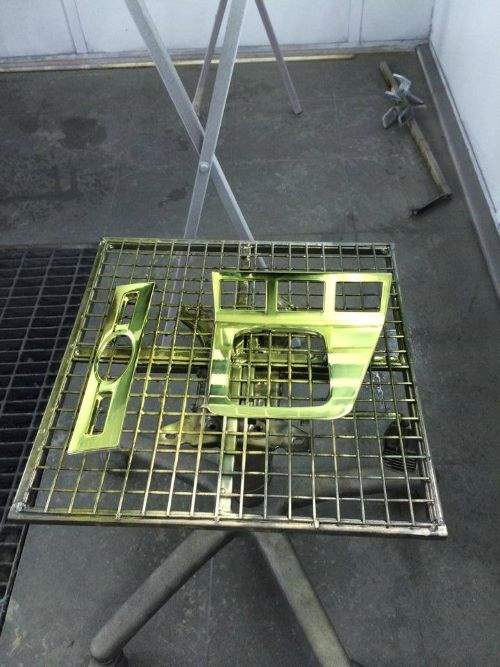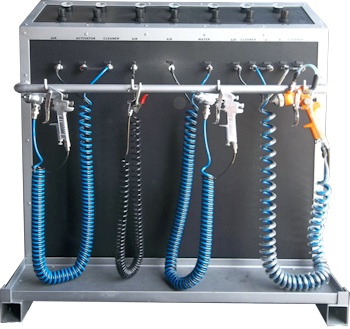All Products are in stock
and shipped from France.
Delivery within 48 hours.
and shipped from France.
Delivery within 48 hours.
Our categories
 Vats for chrome plating
Vats for chrome plating
The silvering technique is a process that requires certain equipment, i.e. guns, hoses and tanks, but also various spare parts for chrome plating to connect everything. It is difficult to do otherwise, because the products are applied simultaneously, or directly following the silvering. We are entering a field that is more akin to chemistry than to painting. Indeed, apart from the phases of the undercoat and the final phase of varnishing, it is exclusively a question of spraying chemicals and chemical reactions.
These products are highly reactive and sensitive. Very different from paints, reactions can occur at an invisible level, that is to say at a molecular level, without one being able to realize it, as is the case with paint with a reaction or a visual defect. To contain them, to convey them and finally to pulverize them, neutral materials are needed which do not react with the chemical nature of the silvering products.
Among these neutral materials and in particular to think what is the right composition for tanks or reservoirs, there are only plastics, glass or ceramics, and finally for metals, stainless steel, i.e. stainless steel.
It is difficult to find tanks with other materials compatible with this technique.
Vats for chrome plating systems
The products that will be filled and sometimes stored in its tanks will be pressurized, sometimes up to 6 bars. Tanks are therefore required that are designed to withstand a certain pressure.
The same is true of course for all the connection components and the pipes, up to the guns and their nozzle.
The tanks under that we offer are made of stainless steel: since the dilute chemicals, which are used for chrome plating by silvering, are very reactive with metals, stainless steel is the best option because it has a limited reactivity with all these acidic or basic products and also these molecules of silver nitrate or tin chloride.
All the chrome plating systems in the world are composed of 4 tanks, which are necessarily :
- the tank to store the water of rinsing
- the tank for storing the silvering product, i.e. the silver in the form of dilute silver nitrate
- the tank for storing the reagent which is sprayed at the same silver nitrate
and finally a last tank which is used to store the ac tivator.
For the latter, since the activator is sprayed in very small quantities, it is sometimes possible to do without this tank and simply store the product in a plastic gun cup. The best tanks for a chrome plating machine are the plastic and ceramic tanks because they offer a reactivity close to 0%.
 Some tips for the proper use of tanks
Some tips for the proper use of tanks
If you open the valve, that is to say the cap of the tanks, you can look inside the tanks and see the contents. It is important to always keep the inside of the tanks wet with ultra pure distilled water. We can see that there are 2 tubes which are used to inject the air and the other to suck the product. These 2 tubes have different sizes :
The small tube is used to blow air to increase the pressure in the tank and must be connected to the air inlet.
The second tube is long and it dives into the product, it is the one who sucks up the liquid to draw it towards the gun.
It often happens that uninformed users connect the tank upside down, that is to say by connecting the air inlet to the suction and the suction to the small tube: the result is that the spraying of the product is bad because the product is not sucked up and an imbalance is then observed in the spraying of the products or the absence of products at the outlet of the gun.
Cleaning tanks for chrome plating
It is important, after each use, to properly purge and rinse the contents of the tanks once or twice in order to keep a work tool in good condition. After rinsing, it is better to leave a little distilled water in the tanks rather than letting them dry, which could produce the formation of dry products which, when used later, will produce bad reactions, which will appear as stains or defects in the chrome plating.
One of the best tips for doing a good spring cleaning and which is valid for any of the 4 tanks but also for the hoses and guns, is the use of chlorine in small quantities diluted in water. Concretely, you can use a little bleach to perform the rinsing. Of course, before use, all residues were evacuated by rinsing, shaking the tanks and emptying them.
We remind you that all residues and waste water must be thrown into a water tank contaminated to be recycled in a specialized center or in a recycling center and must never be discharged into the sewers.














































































